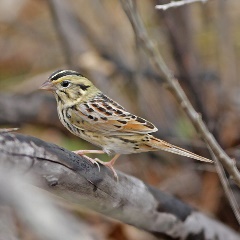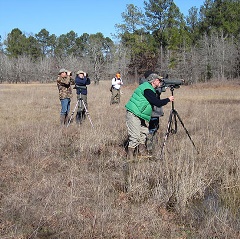In uncertain times, like those caused by a pandemic, it can help to feel like you are part of something bigger. Some find this by participating in long-held traditions, like the National Audubon Society’s Annual Christmas Bird Count (CBC). Now in its 122nd year, the nation’s longest running bird survey is in full swing again, from December 14 through January 5.
 Founded in December 1900 by ornithologist Dr. Frank Chapman, the CBC was an alternative to the holiday “side hunts” that were popular at the time. During side hunts, participants competed to see who could shoot the most birds in one day, resulting in massive numbers of birds killed per hunt. At this time, conservation was in its early stages, but Chapman and other scientists were already concerned about declining bird populations. So, Chapman proposed that people count birds rather than hunt them.
Founded in December 1900 by ornithologist Dr. Frank Chapman, the CBC was an alternative to the holiday “side hunts” that were popular at the time. During side hunts, participants competed to see who could shoot the most birds in one day, resulting in massive numbers of birds killed per hunt. At this time, conservation was in its early stages, but Chapman and other scientists were already concerned about declining bird populations. So, Chapman proposed that people count birds rather than hunt them.
Today, the CBC includes thousands of volunteers across the U.S., Canada, and many other countries in the Western Hemisphere. Local compilers, or trained leaders, coordinate with a state compiler to organize bird counts within a specific local area. On the assigned count day, participants count all birds they encounter within their assigned section of a 15-mile diameter circle. Some watch a bird feeder in their own yard for an hour, while others choose to spend more than 15 hours in the field. Some participants join one bird count; others join many. Birders of all ages and skill levels participate in the CBC, with beginning birders placed within a group of at least one experienced birder.
 Compilers were given the option of canceling their counts or holding their counts with COVID-19 safety protocols (as local laws allow). This year’s CBCs will include wearing masks, social distancing while in the field, carpooling only among family members or social “pod” groups, no in-person compilation gatherings such as potlucks, and all activities must comply with current state and municipal COVID-19 guidelines. Audubon fully supports the decision to cancel a CBC. Those unable to participate in the CBC may be interested in the Great Backyard Bird Count (GBBC), organized by The Cornell Lab of Ornithology and National Audubon Society on President’s Day weekend each February. During this event, participants can count birds each day from their backyard and report results online.
Compilers were given the option of canceling their counts or holding their counts with COVID-19 safety protocols (as local laws allow). This year’s CBCs will include wearing masks, social distancing while in the field, carpooling only among family members or social “pod” groups, no in-person compilation gatherings such as potlucks, and all activities must comply with current state and municipal COVID-19 guidelines. Audubon fully supports the decision to cancel a CBC. Those unable to participate in the CBC may be interested in the Great Backyard Bird Count (GBBC), organized by The Cornell Lab of Ornithology and National Audubon Society on President’s Day weekend each February. During this event, participants can count birds each day from their backyard and report results online.
The data collected by CBC volunteers, from the first bird count to the current count, allow Audubon researchers, conservation biologists, wildlife agencies, and other interested individuals to study the long-term health and status of bird populations across North America. The long-term perspective is vital for conservations, informing strategies to protect birds and their habitat, and helping identify environmental issues with implications for people as well.
To find a CBC near you, visit https://audubon.maps.arcgis.com/apps/View/index.html?appid=ac275eeb01434cedb1c5dcd0fd3fc7b4.
Photos:
Top — Henslow's sparrow (Centronyx henslowii), a rare grassland bird that regularly winters in the saline barrens of Warren Prairie Natural Area. Photo by Robert Herron.
Bottom — Birders at Warren Prairie Natural Area, recognized as a Globally Important Bird Area by the National Audubon Society. Photo by ANHC staff.
Main — Birders braving the snow at Warren Prairie Natural Area. Photo by ANHC staff.
 Founded in December 1900 by ornithologist Dr. Frank Chapman, the CBC was an alternative to the holiday “side hunts” that were popular at the time. During side hunts, participants competed to see who could shoot the most birds in one day, resulting in massive numbers of birds killed per hunt. At this time, conservation was in its early stages, but Chapman and other scientists were already concerned about declining bird populations. So, Chapman proposed that people count birds rather than hunt them.
Founded in December 1900 by ornithologist Dr. Frank Chapman, the CBC was an alternative to the holiday “side hunts” that were popular at the time. During side hunts, participants competed to see who could shoot the most birds in one day, resulting in massive numbers of birds killed per hunt. At this time, conservation was in its early stages, but Chapman and other scientists were already concerned about declining bird populations. So, Chapman proposed that people count birds rather than hunt them. Today, the CBC includes thousands of volunteers across the U.S., Canada, and many other countries in the Western Hemisphere. Local compilers, or trained leaders, coordinate with a state compiler to organize bird counts within a specific local area. On the assigned count day, participants count all birds they encounter within their assigned section of a 15-mile diameter circle. Some watch a bird feeder in their own yard for an hour, while others choose to spend more than 15 hours in the field. Some participants join one bird count; others join many. Birders of all ages and skill levels participate in the CBC, with beginning birders placed within a group of at least one experienced birder.
 Compilers were given the option of canceling their counts or holding their counts with COVID-19 safety protocols (as local laws allow). This year’s CBCs will include wearing masks, social distancing while in the field, carpooling only among family members or social “pod” groups, no in-person compilation gatherings such as potlucks, and all activities must comply with current state and municipal COVID-19 guidelines. Audubon fully supports the decision to cancel a CBC. Those unable to participate in the CBC may be interested in the Great Backyard Bird Count (GBBC), organized by The Cornell Lab of Ornithology and National Audubon Society on President’s Day weekend each February. During this event, participants can count birds each day from their backyard and report results online.
Compilers were given the option of canceling their counts or holding their counts with COVID-19 safety protocols (as local laws allow). This year’s CBCs will include wearing masks, social distancing while in the field, carpooling only among family members or social “pod” groups, no in-person compilation gatherings such as potlucks, and all activities must comply with current state and municipal COVID-19 guidelines. Audubon fully supports the decision to cancel a CBC. Those unable to participate in the CBC may be interested in the Great Backyard Bird Count (GBBC), organized by The Cornell Lab of Ornithology and National Audubon Society on President’s Day weekend each February. During this event, participants can count birds each day from their backyard and report results online.The data collected by CBC volunteers, from the first bird count to the current count, allow Audubon researchers, conservation biologists, wildlife agencies, and other interested individuals to study the long-term health and status of bird populations across North America. The long-term perspective is vital for conservations, informing strategies to protect birds and their habitat, and helping identify environmental issues with implications for people as well.
To find a CBC near you, visit https://audubon.maps.arcgis.com/apps/View/index.html?appid=ac275eeb01434cedb1c5dcd0fd3fc7b4.
Photos:
Top — Henslow's sparrow (Centronyx henslowii), a rare grassland bird that regularly winters in the saline barrens of Warren Prairie Natural Area. Photo by Robert Herron.
Bottom — Birders at Warren Prairie Natural Area, recognized as a Globally Important Bird Area by the National Audubon Society. Photo by ANHC staff.
Main — Birders braving the snow at Warren Prairie Natural Area. Photo by ANHC staff.
